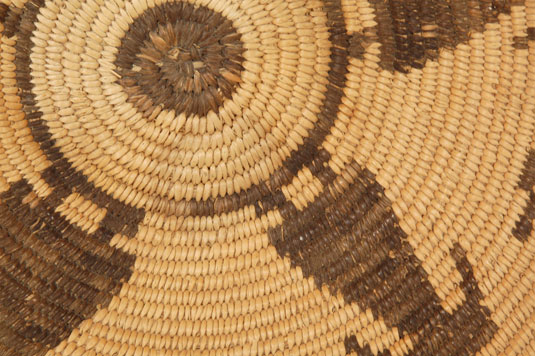Flared Rim Bowl with Five Female Images [SOLD]
+ Add to my watchlist Forward to Friend
- Category: Bowls and Other Forms
- Origin: Maricopa, Peeposh Tribe
- Medium: willow, devil’s claw
- Size: 2-1/2” depth x 12-1/2” diameter
- Item # C3776Z SOLD
Special Value Offer: we have been authorized to offer this at a price reduction of 10% from the original price of $1600 to a new price of $1440.
There are four Native tribes of Yuman-speaking people. They are known today as the Quechans (formerly known as Yumas) Mohaves, Cocopas, and Maricopas. All these tribes formerly made baskets but that has long since ceased. The Maricopa produce pottery today.
The Maricopa formerly consisted of small groups of people situated on the banks of the Colorado River for centuries. In the 16th century, they migrated to the area around the Gila River, to avoid attacks by the Quechan and Mojave peoples. During the 1840s, epidemics took a toll on the tribe. In the 19th century, the Maricopa formed a confederation with the Pima They became successful farmers, however, drought and water diversion by non-Indians brought widespread crop failures.
In the 19th and the 20th centuries, the Bureau of Indian Affairs implemented policies to try to assimilate the Maricopa into mainstream society, and they brought Presbyterian missionaries into the communities. In 1914, the US federal government broke tribal landholdings into individual allotments. The Pima Advisory Council was formed by the BIA in 1926 to speak on behalf of the Pima and Maricopa communities. In 1936 the Pimas and Maricopas agreed on a constitution to restore some measure of self-governance.
Through the 1930s, surface flow on the Gila River was reduced to nothing, and the tribe suffered greatly due to the loss of their river; however, the BIA ignored water issues. The tribe resorted to using brackish well water, incapable of growing edible crops, so the tribe switched to growing cotton. The federal government has done little to nothing to help the Maricopa retain their native cultures and crafts.
This fine pictorial basket could be one of the last made by basket makers of the Maricopa. It dates to the 1920s and was most likely made for sale, not for native use.
Condition: very good condition for its age
Recommended Reading: Indian Baskets of the Southwest by Clara Lee Tanner, University of Arizona Press, Tucson, 1983.
Provenance: from a collection from Colorado

- Category: Bowls and Other Forms
- Origin: Maricopa, Peeposh Tribe
- Medium: willow, devil’s claw
- Size: 2-1/2” depth x 12-1/2” diameter
- Item # C3776Z SOLD



